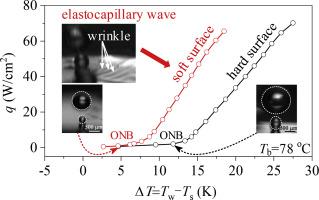当前位置:
X-MOL 学术
›
Int. Commun. Heat Mass Transf.
›
论文详情
Our official English website, www.x-mol.net, welcomes your
feedback! (Note: you will need to create a separate account there.)
Self-activated elastocapillary wave promotes boiling heat transfer on soft liquid metal surface
International Communications in Heat and Mass Transfer ( IF 6.4 ) Pub Date : 2021-01-01 , DOI: 10.1016/j.icheatmasstransfer.2020.105019 Chunlei Cao , Xiaojing Ma , Xiaotian He , Jinliang Xu , Jian Xie , Guohua Liu
International Communications in Heat and Mass Transfer ( IF 6.4 ) Pub Date : 2021-01-01 , DOI: 10.1016/j.icheatmasstransfer.2020.105019 Chunlei Cao , Xiaojing Ma , Xiaotian He , Jinliang Xu , Jian Xie , Guohua Liu

|
Abstract Current studies use stiff micro/nano structure to augment boiling heat transfer, there is a superheating boundary layer near the hard structure to dominate the boiling process. Here, comparative studies were performed for pool boiling of ethanol on a hard copper surface and a ~100 μm soft Galinstan liquid metal surface. The latter behaves significant heat transfer enhancement, which is more evident for saturated boiling, under which heat transfer coefficients are raised by 60.5% compared to bare copper surface, maximally. The soft surface decreases bubble departure size by half, and increases bubble departure frequency by ~7 times. These distinct characteristics of bubble dynamics result in the decrease of wall superheating at onset of nucleate boiling from ~13 K on hard copper surface to ~5 K on soft surface. Elastocapillary wave and dynamic wrinkles are observed to disturb the near wall boundary layer for heat transfer enhancement, which are formed by the energy and force interactions between departing bubbles and soft liquid metal. The easier bubble nucleation on soft surface agrees with the bubble nucleation theory for a system including two immiscible liquids. Our study provides an alternative way using self-activated elastocapillary wave to promote boiling heat transfer.
中文翻译:

自激活弹性毛细管波促进软液态金属表面沸腾传热
摘要 目前的研究使用硬质微/纳米结构来增强沸腾传热,在硬质结构附近存在过热边界层来主导沸腾过程。在这里,对硬铜表面和 ~100 μm 软 Galinstan 液态金属表面上的乙醇池沸腾进行了比较研究。后者表现出显着的传热增强,这对于饱和沸腾更为明显,与裸铜表面相比,传热系数最大提高了60.5%。柔软的表面使气泡脱离尺寸减少了一半,并使气泡脱离频率增加了约 7 倍。气泡动力学的这些独特特征导致在核沸腾开始时壁面过热从硬铜表面的~13 K 降低到软表面的~5 K。观察到弹性毛细管波和动态皱纹干扰近壁边界层以增强传热,这是由离开的气泡和软液态金属之间的能量和力相互作用形成的。在软表面上更容易气泡成核与包含两种不混溶液体的系统的气泡成核理论一致。我们的研究提供了一种使用自激活弹性毛细管波促进沸腾传热的替代方法。
更新日期:2021-01-01
中文翻译:

自激活弹性毛细管波促进软液态金属表面沸腾传热
摘要 目前的研究使用硬质微/纳米结构来增强沸腾传热,在硬质结构附近存在过热边界层来主导沸腾过程。在这里,对硬铜表面和 ~100 μm 软 Galinstan 液态金属表面上的乙醇池沸腾进行了比较研究。后者表现出显着的传热增强,这对于饱和沸腾更为明显,与裸铜表面相比,传热系数最大提高了60.5%。柔软的表面使气泡脱离尺寸减少了一半,并使气泡脱离频率增加了约 7 倍。气泡动力学的这些独特特征导致在核沸腾开始时壁面过热从硬铜表面的~13 K 降低到软表面的~5 K。观察到弹性毛细管波和动态皱纹干扰近壁边界层以增强传热,这是由离开的气泡和软液态金属之间的能量和力相互作用形成的。在软表面上更容易气泡成核与包含两种不混溶液体的系统的气泡成核理论一致。我们的研究提供了一种使用自激活弹性毛细管波促进沸腾传热的替代方法。









































 京公网安备 11010802027423号
京公网安备 11010802027423号